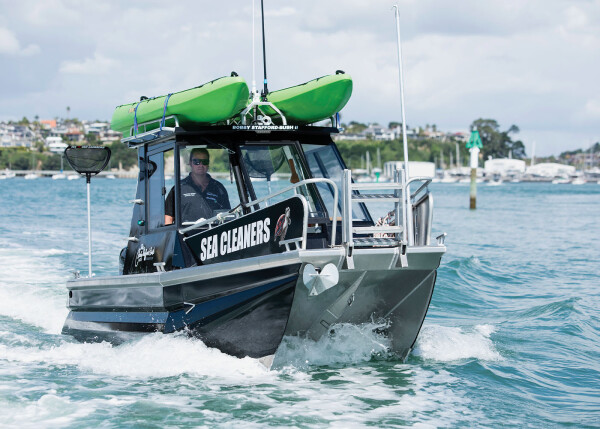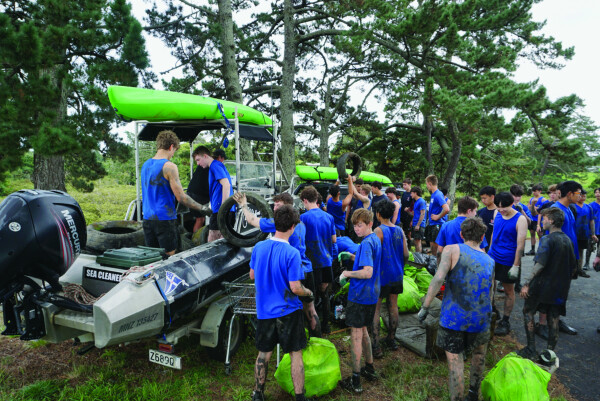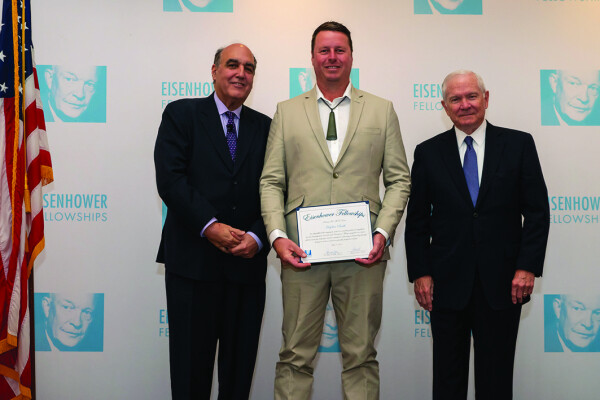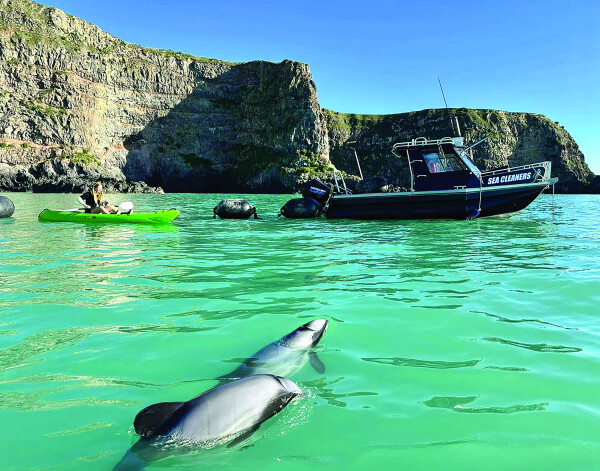For the good of our ocean
Mar 20, 2024

In 2017, TE KARAKA spent the day on board with Hayden Smith, founder and CEO of Sea Cleaners. In this issue, we catch up with Hayden to see how the Sea Cleaners kaupapa is going, and learn how his simple dream to clean up our environment is turning into a global operation. Nā Anna Brankin.
The first Sea Cleaners vessel was launched in 2002, the result of Hayden’s determination to clean up the huge rubbish convergence he saw in Auckland’s Waitematā Harbour while working as a kayak guide.
“I had always felt a strong connection to the natural environment, and living and working in it every day only made the connection stronger,” Hayden says. “I couldn’t believe the amount of rubbish flowing underneath the Auckland Harbour Bridge and I thought, ‘Why is no-one out here cleaning this up? This is something I could do.’”
Hayden (Kāi Tahu – Kāti Huirapa Rūnaka ki Puketeraki) approached the Auckland City Council to do just that. It was the beginning of a two-year journey to get the first Sea Cleaners boat on the water.
“Everyone thought it was a good idea but no-one knew what to do about it. I was bounced around all the different departments and councils in the region of Auckland,” he says. “Every person I met gave me another little piece of advice that I was able to compile into an increasingly comprehensive business plan.”
Eventually, Hayden got a business plan in front of the then mayor, Sir Bob Harvey, who immediately saw its potential. He remains a patron of Sea Cleaners to this day, and it was with his support that the first boat was launched in December 2002, donated by Ports of Auckland and named the Phil Warren in honour of the late Regional Council Chair.
“I was basically given a licence to go out and prove what I said I’d seen and what I could do about it,” says Hayden. Twenty-one years later, he has done just that.
“Each crew is collecting on average 2,000 litres of rubbish a day, that’s about 40,000 litres a month which is more than a shipping container,” Hayden says. This adds up to more than 17.5 million litres of rubbish since Sea Cleaners began, most of which heads to Northland Waste. More recently, however, the crew have been sorting and redirecting plastic waste to Future Post, a company making fence posts out of recycled plastic.
“We’ve actually been able to make indirect change through those partnerships, as Northland Waste is now diverting plastics from their landfills and sending it off to Future Post as well,” says Hayden.
“So through our own desire to find a better solution for the waste we collect, we’ve actually helped landfill operations to find a better solution for the waste they receive as well.”
Besides this, the Sea Cleaners crew return a lot of marine farming equipment that can then be reused, as well as sending any tyres they find off to be repurposed into cement. And, Hayden says, the hope is that simply by being out there and doing what they do, the Sea Cleaners’ message will spread.
“Our boats are pretty well-branded and it’s pretty self-explanatory, so they do get noticed when they’re out and about and there’s some genuine love and appreciation for the work that we’re doing.”
Three boats cover the wider Auckland region, while their Northland boat operates out of the Bay of Islands. In January 2023, Hayden was proud to launch the first vessel in Te Waipounamu, operating out of Lyttelton and covering the entire Canterbury region. Each vessel covers around 600 kilometres of coastline. They also have a hovercraft in the fleet, used in tidal mudflats.

Hayden Smith on board one of the Sea Cleaners vessels.
“We’ve actually got another five boats on standby, subsequent to getting funding in place, and they’ll go to the Bay of Plenty, Wellington, Marlborough, Tasman and Otago,” Hayden says. “That’ll give us pretty good coverage across the country. We just want to get them out there and working.”
Although the Phil Warren has to stay on its berth in Westhaven Marina, the rest of the Sea Cleaners fleet are purpose-built trailer boats that can be launched and anchored anywhere, with crew and volunteers able to step off the bow onto the beach. Each boat has a skipper and a deckhand, meaning the entire Sea Cleaners operation consists of 10 kaimahi as well as Hayden and his wife.
“We make every dollar count, and every dollar that we do raise goes directly towards making sure our boats are out there doing what they do,” Hayden says. “They’re out there five days a week, cleaning up the coast and engaging the communities to make our places better.”

A clean up mission on the Tamaki River with students from Kings College.
These days, Hayden doesn’t spend as much time on the water as he used to. His top priority is keeping the fleet on the water – and expanding it – so most of his time is spent networking and fundraising. The biggest supporters for Sea Cleaners are local councils, as well as organisations such as the Rātā Foundation and philanthropic or private family trusts.
“I spend the bulk of my time following up on leads and networking, getting out there and showcasing who we are and what we’ve been doing,” Hayden says. “Twenty-one years on, and our work is far from done.”
The work that Sea Cleaners has done upstream has eliminated a lot of the convergence zones full of rubbish, but there is definitely enough new waste created to keep the team busy.
“Consumerism is still rampant, and the amount of plastics and debris constantly coming at us as a society hasn’t changed,” Hayden says. “There are 101 reasons rubbish ends up in the open environment, and every time it rains everything comes down through the stormwater systems and ends up coming out to sea.”
With so much work to be done, Hayden is grateful to the network of volunteers who support Sea Cleaners.
“It can be disheartening but I’m genuinely inspired by the amount of volunteers who put their hands up wanting to help. We always have at least two or three out with each crew,” Hayden says. “Wherever I am in the country, I make sure to get down to the boat first thing in the morning to see them off, just to be a part of that energy because it’s always a real buzz.”
Besides their contribution to the clean-up effort, volunteers play an important role as advocates for the Sea Cleaners kaupapa.
“Volunteering is a critical component of the Sea Cleaners model, because we see our boats as our classrooms,” Hayden says. “We’re able to educate those volunteers, to show them the effects of littering and show them the impact of the work that we do, so they can spread the word and help us secure the sponsorship and funding that we need to operate.”
Beside the daily operations of the Sea Cleaners fleet, Hayden is also determined to educate new generations of consumers about the impact of plastic on the environment.

Hayden (centre) was made a fellow of the Eisenhower Fellowship in 2023. Pictured here with George de Lama, Eisenhower Fellowship President (left); and Dr Robert M. Gates (right), Eisenhower Fellowship Chairman at the ceremony.
He takes the time to respond to regular queries from students who pick Sea Cleaners as the topic for school projects, and does in-school presentations about the impact of littering on the environment.
More recently, Hayden has also been spearheading a global ambassador programme. Supported by the Hawaiian Tourism Authority and Hawaiian Airlines, a cohort of students from across New Zealand and Australia travels to Hawaii in September each year. They spend three weeks cleaning up local beaches and honing their public
speaking skills.
“We get them into local schools and have them speak about their experiences out on the coast of the Hawaiian islands,” says Hayden.
“It’s about creating a tourism story that is not about just going to a tropical destination and using and abusing the environment. We’re actually leaving the place better than we found it.”
The programme also aims to teach participants about our responsibility as global citizens, as a lot of the rubbish collected on the Hawaiian islands comes out of the Great Pacific Garbage Patch, meaning they’re being affected by international debris on top of their own waste production.
“There’s also a really lovely cultural aspect to it as well. The Hawaiian culture is very similar to Māori culture in terms of how we do things, and sharing those cultures in respect to caring for our environment has been amazing,” says Hayden.
Although Sea Cleaners would love to grow its international presence one day, for now Hayden and the team are focusing their efforts at home. “We want to make sure we’ve got as many boats funded to operate in New Zealand first, and that we’re doing the best possible job we can.
I just love this place and I want to make sure we leave it as good as we can.”

At work under the watchful eye of Hauraki Gulf locals.